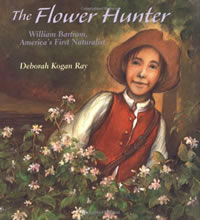 “My father, John Bartram, is a botanist. He studies plants and trees. I help him with his work. My name is William, but everyone calls me Billy. Father calls me his ‘little botanist.'”
“My father, John Bartram, is a botanist. He studies plants and trees. I help him with his work. My name is William, but everyone calls me Billy. Father calls me his ‘little botanist.'”
Thus Deborah Kogan Ray begins her first person narrative of the life of William Bartram (1739-1823) in “The Flower Hunter,” a book written for children that can be read with enjoyment by adults as well. Much has been written about this early American naturalist and artist — and his equally famous botanist father, John Bartram (1699-1777) — but none can match the charm of this 40-page book, which is richly illustrated by the author.
“The Flower Hunter” tells the story of a young boy who grows up on a farm near Philadelphia and early becomes fascinated by his father’s love of plants and botanical exploration. Throughout his childhood, Billy’s father leads him on field trips that range farther and farther away from the farm. Eventually their roles reverse, and the son becomes an explorer who returns home triumphantly to share his discoveries about the natural world with his aging father.
Kogan Ray places her straightforward account against a wider backdrop — the struggles of an emerging nation and the hardships and thrills of travel through a landscape and time very different from today. New plants, animals and even peoples are waiting to be found, described and – unusual for scientific traditions of the time — cherished in their natural state.
Why do the Bartrams remain important to us now? Together they discovered the Franklin tree (Franklinia alatamaha) in coastal Georgia in 1765; a short time later the tree became extinct in the wild. An example of this beautiful tree, that blooms in autumn while its foliage is turning bright red, can be found on the east edge of the Arboretum’s Azalea Way, about 100 yards north of the Winter Garden.
While today’s botanic gardens and arboreta would be duller places without the Franklin tree, the Bartrams left us far more than this one showstopper. Their farm became one of the first botanic gardens in the United States, and is open to the public. (see “Bartram’s Garden website). And they were instrumental, along with their friend Benjamin Franklin and others, in developing an American tradition of studying the natural sciences.
Perhaps best, they both wrote detailed journals of their travels. William’s “Travels,” published in 1791, is still in print today and is credited by Kogan Ray with having “inspired Henry David Thoreau and Charles Darwin with its observations of the world of nature.”
Excerpted from the Summer 2008 Arboretum Bulletin.